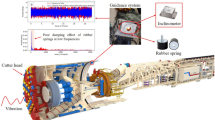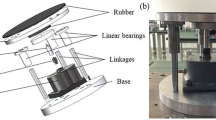Abstract
The vibration disturbance from an external environment affects the machining accuracy of ultra-precision machining equipment. Most active vibration-isolation systems (AVIS) have been developed based on static loads. When a vibration-isolation load changes dynamically during ultra-precision turning lathe machining, the system parameters change, and the efficiency of the active vibration-isolation system based on the traditional control strategy deteriorates. To solve this problem, this paper proposes a vibration-isolation control strategy based on a genetic algorithm-back propagation neural network-PID control (GA-BP-PID), which can automatically adjust the control parameters according to the machining conditions. Vibration-isolation simulations and experiments based on passive vibration isolation, a PID algorithm, and the GA-BP-PID algorithm under dynamic load machining conditions were conducted. The experimental results demonstrated that the active vibration-isolation control strategy designed in this study could effectively attenuate vibration disturbances in the external environment under dynamic load conditions. This design is reasonable and feasible.




























Similar content being viewed by others
References
Ma S, Zhang GQ, Wang JP et al (2022) An on-line identification method of tool-below-center error in single-point diamond turning. J Manuf Process 79:154–165
Jiang X, Guo M, Li B (2018) Active control of high-frequency tool-workpiece vibration in micro-grinding. Int J Adv Manuf Technol 94(1/4):1429–1439
Ma H, Guo J, Wu J et al (2020) An active control method for chatter suppression in thin plate turning. IEEE Trans Ind Inf 16(3):1742–1753
Qian F, Wu Z, Zhang M et al (2019) Youla parameterized adaptive vibration control against deterministic and band-limited random signals. Mech Syst Signal Process 134:106359. https://doi.org/10.1016/j.ymssp.2019.106359
Ding YY, Rui XT, Chen YH et al (2023) Theoretical and experimental investigation on the surface stripes formation in ultra-precision fly cutting machining. Int J Adv Manuf Technol 124:1041–1063. https://doi.org/10.1007/s00170-022-10493-9
Chai YY, Jing XJ, Chao X (2022) X-shaped mechanism based enhanced tunable QZS property for passive vibration isolation. Int J Mech Sci 218:107077. https://doi.org/10.1016/j.ijmecsci.2022.107077
Yan G, Qi WH, Shi JW et al (2022) Bionic paw-inspired structure for vibration isolation with novel nonlinear compensation mechanism. J Sound Vib 525:116799. https://doi.org/10.1016/j.jsv.2022.116799r
Yang B, Hu Y, Fang H et al (2017) Research on arrangement scheme of magnetic suspension isolator for multi-degree freedom vibration isolation system. J Ind Inf Integr 6:47–55
Zhang B, Dong W, Li X et al (2020) Design of active-passive composite vibration isolation system of magnetic levitation and spring based on fuzzy PID control. In: Chinese automation congress, Shanghai, 6‒8 November, pp 2381–2386
Xu J, Yang X, Li W et al (2020) Research on semi-active vibration isolation system based on electromagnetic spring. Mech Ind 21(1):101. https://doi.org/10.1051/meca/2019048
Kheiri Sarabi B, Sharma M, Kaur D (2018) Active vibration control based on LQR technique for two degrees of freedom system. In: Nandi A, Sujatha N, Menaka R et al (eds) Computational signal processing and analysis. Lecture notes in electrical engineering, vol 490, Springer, Singapore. https://doi.org/10.1007/978-981-10-8354-9_15
Jiang D, Li J, Li X et al (2020) Modeling identification and control of a 6-DOF active vibration isolation system driving by voice coil motors with a Halbach array magnet. J Mech Sci Technol 34(2):617–630
Ab Rahim S, Muthalif AGA, Tunthim KK et al (2019) Active vibration isolation system (AVIS) using a voice coil actuator to improve free space optics communication. In: IEEE 10th control and system graduate research colloquium (ICSGRC), Shah Alam, Malaysia. https://doi.org/10.1109/ICSGRC.2019.8837053
Lee JH, Kim HY, Kim KH et al (2017) Control of a hybrid active–passive vibration isolation system. J Mech Sci Technol 31(12):5711–5719
Chen F (2018) Vibration suppression with electromagnetic hybrid vibration isolators. In: The 9th international conference on mechatronics and manufacturing (ICMM 2018), Phuket, Thailand. https://doi.org/10.1088/1757-899X/361/1/012012
Yonezawa H, Kajiwara I, Yonezawa A et al (2019) Model-free vibration control to enable vibration suppression of arbitrary structures. In: The 12th Asian control conference (ASCC), Kitakyushu, Japan, pp 289–294
Liu YJ, Xu H, Zhang YG et al (2017) Burner-electrode position control of calcium carbide furnace based on BP-PID controller. In: IEEE international conference on mechatronics and automation (ICMA), Takamatsu, Japan. https://doi.org/10.1109/ICMA.2017.8015920
Wang JL, Tan R, Nie LY (2022) A steady-state flight control algorithm combining stretching ratio coefficient and PID control for UAVs in uncertain environments. Sustainability 14(22):14678. https://doi.org/10.3390/su142214678
Song C, Yu C, Xiao Y et al (2017) Fuzzy logic control based on genetic algorithm for a multi-source excitations floating raft active vibration isolation system. Adv Mech Eng 9(6):1–13
Su Z, Li W, Xie W (2019) Simulation analysis of control system for six degrees of freedom damping platform based on Matlab. In: IOP conference series: materials science and engineering, vol 612, pp 032078. https://doi.org/10.1088/1757-899X/612/3/032078
Liu Y, Jiang D, Yun JT et al (2022) Self-tuning control of manipulator positioning based on fuzzy PID and PSO algorithm. Front Bioeng Biotechnol 9:12. https://doi.org/10.3389/fbioe.2021.817723
Yang L, Su K, Liu S et al (2017) Study on active vibration isolation system using neural network sliding mode control. J Vibroengineering 19(8):6094–6104
Liu J, Li X, Zhang X et al (2019) Modeling and simulation of energy-regenerative active suspension based on BP neural network PID control. Shock Vib 2019:4609754. https://doi.org/10.1155/2019/4609754
Wang R, Yang S, Wang D (2019) Intelligent piezoelectric peristaltic linear driving model based on neural network. J Intell Fuzzy Syst 37(1):455–465
Gulcu S (2022) Training of the feed forward artificial neural networks using dragonfly algorithm. Appl Soft Comput 124:109023. https://doi.org/10.1016/j.asoc.2022.109023
Ren HJ, Hou B, Zhou G et al (2020) Variable pitch active disturbance rejection control of wind turbines based on BP neural network PID. IEEE Access 8:71782–71797
Ye HY, Ni XD, Chen HJ et al (2022) Constant speed control of hydraulic travel system based on neural network algorithm. Processes 10(5):17. https://doi.org/10.3390/pr10050944
Song L, Huang LJ, Long B et al (2020) A genetic-algorithm-based DC current minimization scheme for transformless grid-connected photovoltaic inverters. Energies 13(3):746. https://doi.org/10.3390/en13030746
Yang J, Hu YP, Zhang KX et al (2021) An improved evolution algorithm using population competition genetic algorithm and self-correction BP neural network based on fitness landscape. Soft Comput 25(3):1751–1776
Chen YP, Liu SR, Xiong C et al (2019) Research on UAV flight tracking control based on genetic algorithm optimization and improved bp neural network pid control. In: 2019 Chinese automation congress (CAC), Hangzhou, China. https://doi.org/10.1109/CAC48633.2019.8996179
Zhang XL, Fan HM, Zang JY et al (2015) Nonlinear control of triple inverted pendulum based on GA-PIDNN. Nonlinear Dyn 79(2):1185–1194
Funding
This work was supported by the National Natural Science Foundation of China (Grant Nos. 62073184, 52105490).
Author information
Authors and Affiliations
Corresponding author
Rights and permissions
Springer Nature or its licensor (e.g., a society or other partner) holds exclusive rights to this article under a publishing agreement with the author(s) or other rightsholder(s); author self-archiving of the accepted manuscript version of this article is solely governed by the terms of such publishing agreement and applicable law.
About this article
Cite this article
Wang, B., Jiang, Z. & Hu, PD. Study on 6-DOF active vibration-isolation system of the ultra-precision turning lathe based on GA-BP-PID control for dynamic loads. Adv. Manuf. 12, 33–60 (2024). https://doi.org/10.1007/s40436-023-00463-z
Received:
Revised:
Accepted:
Published:
Issue Date:
DOI: https://doi.org/10.1007/s40436-023-00463-z




